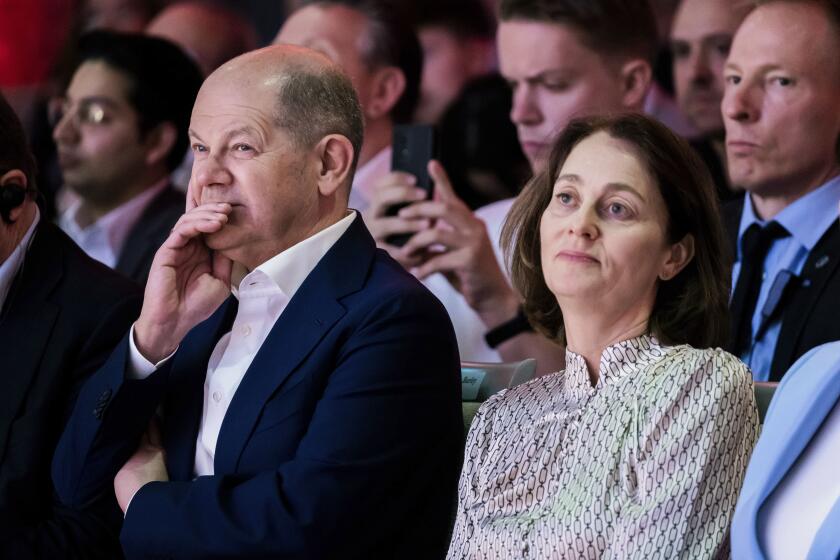War Drove Southland’s Explosive Growth
Two thousand three hundred Americans died. Nineteen ships burned or went to the bottom.
Before the peace was won, 16.4 million U.S. men and women would be drawn into military service.
The Atomic Age would explode in anger.
The nation would send 110,000 Japanese Americans into detention camps.
American families would be scattered hither and far like never before.
Japan would be humbled, Germany divided.
That lazy Sunday when attack planes of the Imperial Japanese Navy roared over the horizon toward Oahu and the Philippines, the United States was brought into a global war that would kill 45 million people.
The world has regrouped since, and regrouped again. Japan is no longer humbled--its people no longer derisively called “Japs”--and Germany is no longer divided. But the Day of Infamy touches us still.
The bugle blows each Dec. 7 over the seeping wreckage of the Arizona. Tears for what might have been fall on stunted forests of white gravestones. Our nightmare is to receive what we delivered from the great Bomb that now perilously enforces the peace.
Our everyday lives, even now, answer to patterns set in motion that day, and hardly anywhere as much as in Southern California.
The stage was set by men like Donald Douglas. As the story is told, Douglas and a Los Angeles Times reporter-turned-ad man named Bill Henry rented a barbershop in Los Angeles to design airplanes after World War I. They started with a $1,000 grubstake and a contract to build three torpedo planes for the Navy.
Two years after Pearl Harbor, Douglas and the other Southland aircraft companies were bigger than industrial Detroit ever had been.
“In any logical scheme the aviation industry should be back in the manufacturing center of the country and not out in a beautiful resort like this,” Robert Gross, then president of Lockheed, told a reporter. “The reason we’re here is that Donald Douglas came here to make planes and the rest of us followed.”
That, and Pearl Harbor.
Southern California just happened to be ready to grow. It boasted the largest man-made harbor in the world. The 400-mile Colorado River Aqueduct was finished in 1941, just before the war began, and its champions boasted it could sustain an unthinkable population of 10 million.
As the war industry gained steam, Los Angeles became the No. 2 industrial county in the country. The city’s population passed that of Detroit and Philadelphia, making it the America’s third-largest city. Black Americans, hungry for well-paying jobs and escape from Texas and Louisiana, streamed to California.
In November 1943, Life magazine carried its usual patriotic cover with a photograph titled “Foot Soldier.” But pages inside showed a country shifting its thinking to the giddy prospects of life after the war.
In an article called “Los Angeles Is the Damnedest Place,” writer Roger Butterfield saw the future. There were more cars per capita here than anywhere. This was the home of the drive-in restaurant and, imagine, even the drive-in bank. Civic boosters were dreaming of a web of express highways called “freeways.”
The local Chamber of Commerce had a branch office in Mexico City. The city’s resistance to unions made it a mecca for what Butterfield called “enterprisers,” now known as entrepreneurs. Everyone was thinking big.
A transitory ethos had taken hold already. “The wonderful part about Los Angeles is that you could tear down the whole thing tomorrow and you wouldn’t lose anything,” architect Sumner Spaulding said.
The dizzy boomtown also had a particular draw on what Butterfield described as “evangelists, chiropractors, diet faddists, fake prophets, quack doctors, genuine mystics and genuine freaks.”
There would be no real downtown. This would be a place that “reached out from the mountains to the sea, like a gigantic wallowing amoeba swallowing up some towns, surrounding others, squirming through bottlenecks and draping itself over deserts and canyons.”
Americans found the whole crazy stew irresistible. In a poll, 90% of wartime aircraft workers in Los Angeles planned to stay.
Writer Westbrook Pegler would look out upon California’s subdivisions and wonder, “How could they make the same mistake so many times?” But to a man stepping off a troopship, a new house in the sunshine, with a backyard and a fence, was truly a castle.
“Boy, I never dreamed there was such a place as this,” a soldier told Butterfield. “Mister, I’m coming back here to live after the war, and I’m going to bring my family too. Mister, this is dreamland.”
Pearl Harbor pulled us into war. Southern California helped pull us out.
More to Read
Start your day right
Sign up for Essential California for news, features and recommendations from the L.A. Times and beyond in your inbox six days a week.
You may occasionally receive promotional content from the Los Angeles Times.






